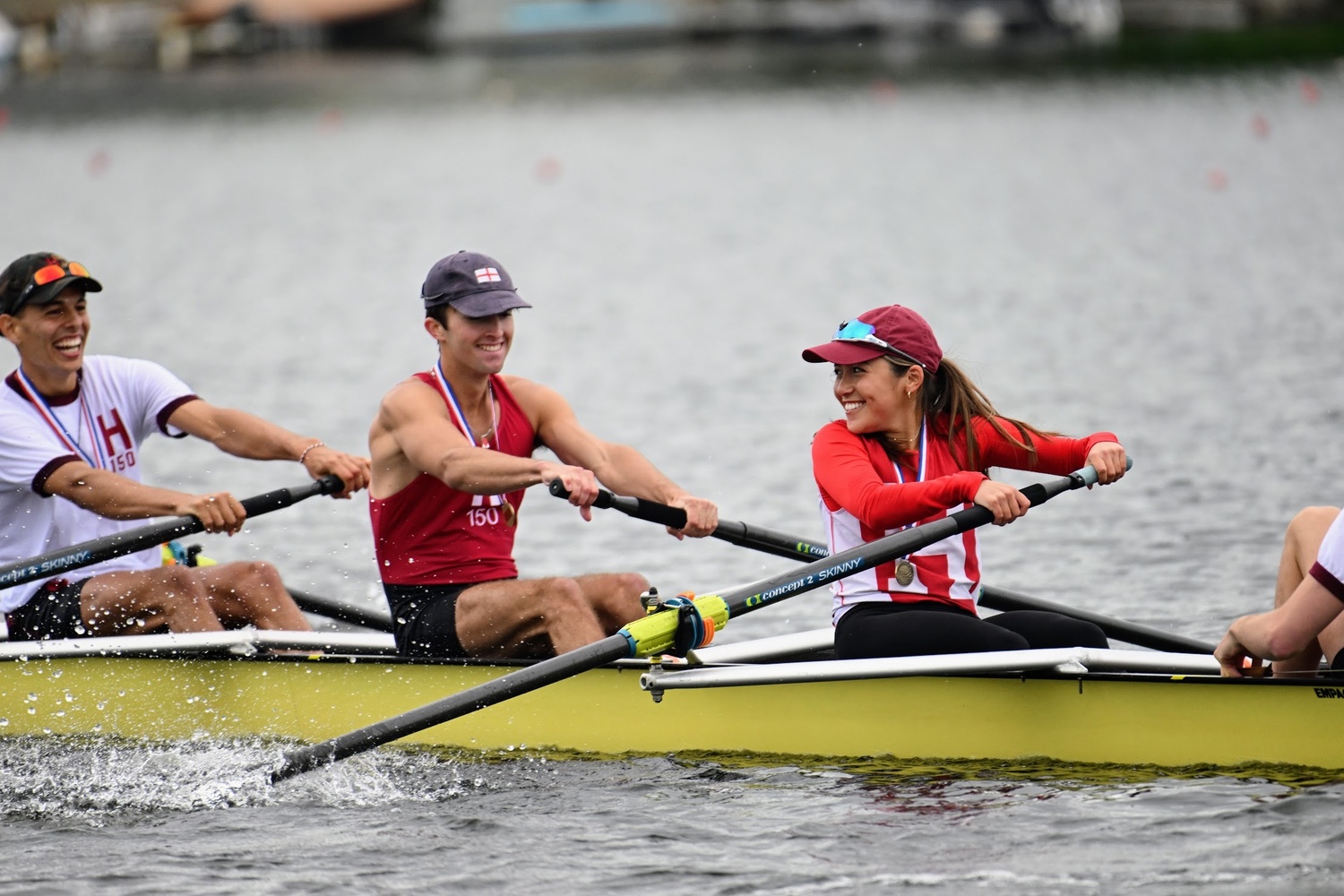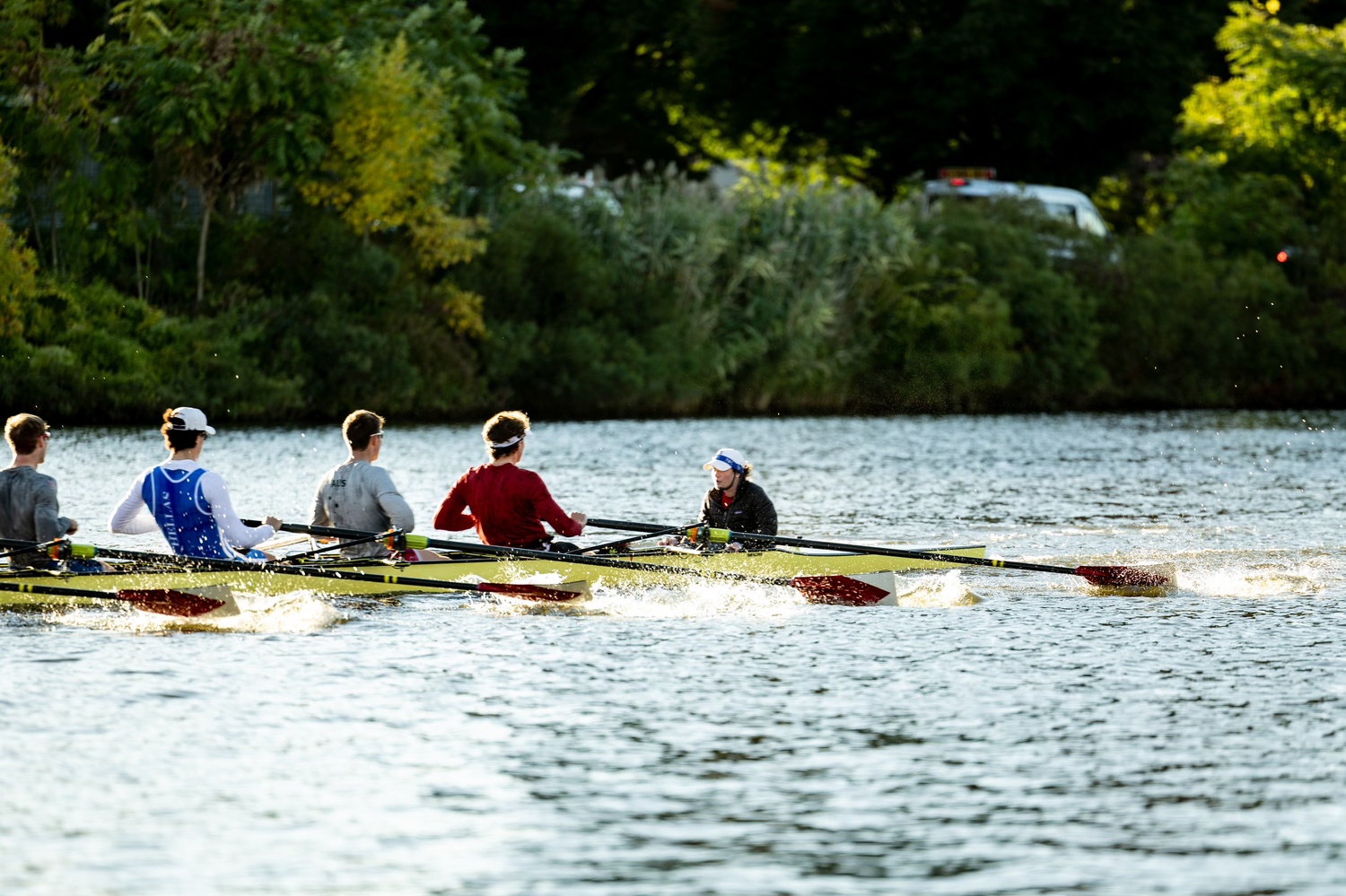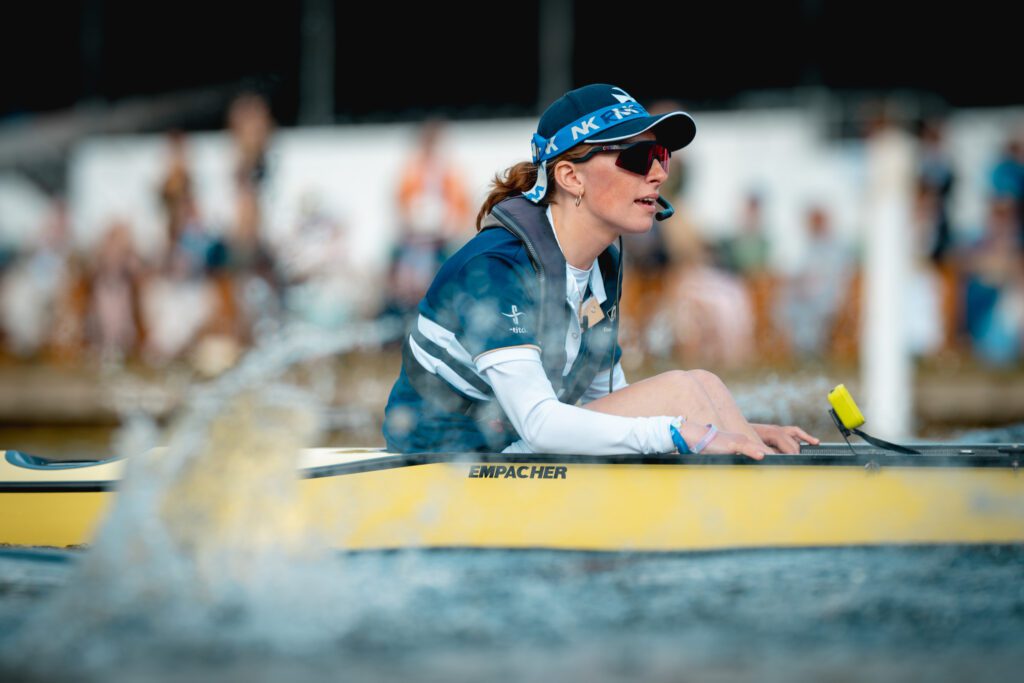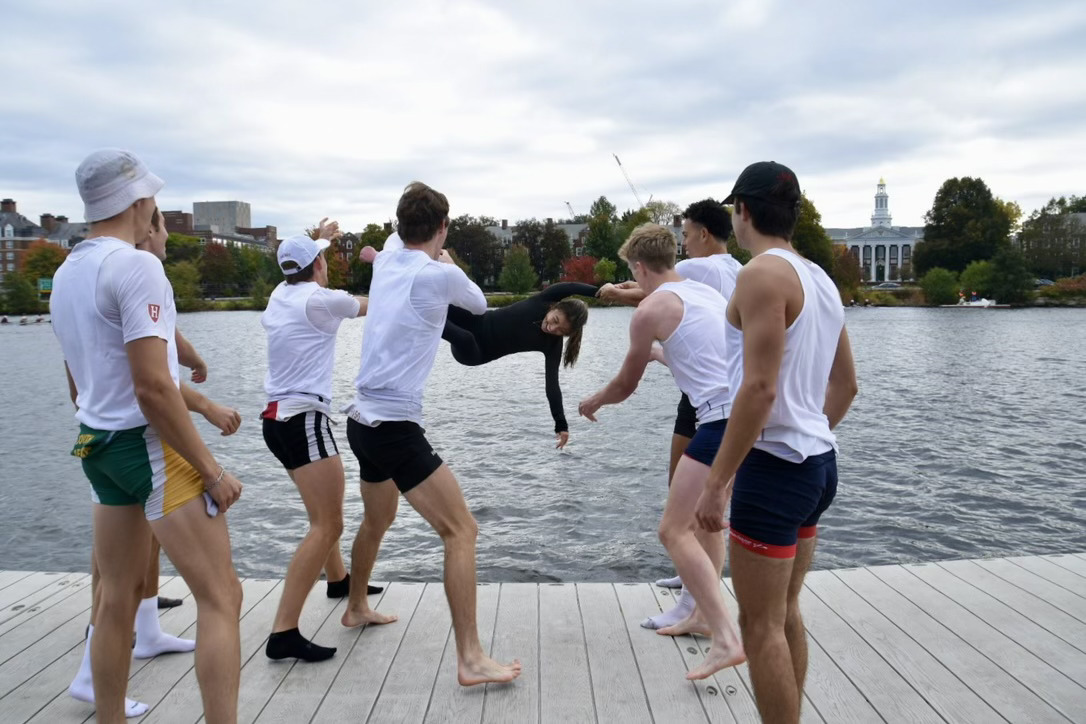‘The Power of a Female Coxswain’: An Unsung Hero of the Head of the Charles
It might seem daunting to think about steering a boat around tricky twists and turns while barreling down a river at full throttle, but the female coxswains on Harvard’s men’s crew teams do so with a commanding grace.
It might seem daunting to think about steering a boat around tricky twists and turns while barreling down a river at full throttle, but the female coxswains on Harvard’s men’s crew teams do so with a commanding grace, all while leading a group of eight men who are double their size. Slotted in their seats at the head of their vessels, these female coxswains run their ships with the confidence to keep eight rowers in perfect cadence, out-performing some of the best collegiate programs in the nation.
Senior Anya Cheng is perhaps the most acclaimed coxswain on the varsity roster. Named the IRCA Coxswain of the Year and a member of the IRCA Crew of the Year last year, following a National Championship victory with the lightweight Varsity Eight, Cheng is looking to clinch her third straight Head of the Charles win with the crew this weekend. The Wellesley, Mass. native walked onto the crew team her freshman fall and has made an instant impact with the program.
Senior Georgina Younes has taken a nontraditional path to coxing. She joined the men’s heavyweight team her junior fall to fill a gap in the roster, learning on the job on an impressively expedited timeline.
Taking what might be considered a more traditional route in walking onto the men’s heavyweight team, senior Cate Engles worked her way up through the novice program during her freshman fall before making her mark with the 5V8. Despite going abroad for a semester during her junior year, the Akron, Ohio native has re-emerged on the team this season and is looking to make waves at the HOCR this weekend.
Freshman coxswain Natalia Toms brings with her an entirely different set of experiences from the other female coxswains. Toms, who was a recruited commit for the Harvard team, was the first girl to cox a men’s eight for Great Britain, where she clinched gold at the 2023 U19 World Championships. The Shrewsbury, U.K. native has already shown her prowess in the boat just a few months into her collegiate career, and will be a name to watch this weekend.
Engles hoped that her coach’s decision to recruit a female coxswain would put future coxswains on the team in greater positions of power.
“Sometimes I do feel like, as a female coxswain, you can be underestimated,” Engles explained, recounting how during her tenure at Harvard coaches would consistently opt to recruit male coxswains over female coxswains, then privilege those recruits over female walk-ons.
“There were two seniors, very, very good coxswains, both of them, but everyone always knew the boy was gonna have the Varsity,” explained Engles, recounting the experience. So I think if anything were to change, I would say the power of a female coxswain should not be underestimated.”
Learning on the Job
As walk-ons, coxswains are typically at a disadvantage from their peers. With only one coxswain recruited every three or four years, Harvard’s four crews are mostly captained by walk-ons who have never participated in the sport. Especially at a school with such a storied history of successful crews, walking onto a team without any knowledge of the sport can be daunting.
“The truth about being a coxswain is that you have to bounce back from making a mistake probably eight times a practice,” Cheng said. “And it’s really important to have a thick skin, and to let things roll off your back. That’s actually one of the things I’m worst at — letting things roll off my back. I take everything I do really seriously, and so when I make a mistake, it really, really gets me.”
“It’s an easy position to be a scapegoat in, which is something you just have to accept and let roll off your back,” Cheng added.
Because the women are often put in this tenuous position of taking blame for the boat’s mistakes, they have to learn to take control of a boat in which the power dynamics are stacked against them.
“When I walked onto the team, I was new and they had experience. When you’re a woman, you’re shorter than them. You’re one, and there’s eight of them,” Cheng said. “And so there’s a lot of ways that you’re on the bottom end of a power dynamic. You’re also told you need to tell them what to do, and you need to be sure of it.”
“And that was really, really hard for me to adjust to at first,” Cheng added. “It’s really hard to feel confident in a situation where, in a lot of ways, it feels like the deck is stacked against you.”
While Cheng started on the team in a somewhat isolated position, Engles had the advantage of walking onto the team alongside a group of friends who were also working through the novice program. This afforded her a sense of reassurance as she coxed a boat of crewsmen also new to the challenges of racing along the Charles.
The novice crew team at Harvard has been a historically prominent training ground for rowers and coxswains new to the sport, and Engles spoke to the exhilarating feeling of accomplishment that came with beating the lightweight crew team during The Foot of the Charles race her freshman year — the culmination of a semester-long effort on her boat to find its rhythm.
“We had one job: beat the lightweights,” said Engles, describing her mentality heading into that race in late 2021. “And we did it. It’s my fondest Harvard memory, just me and these walk-on guys trying our best. It was my first time ever coxing a race, but it was just so much fun. I loved it, and I stuck with it.”
Engles’ love for the team was so contagious that she took it upon herself to recruit Younes to join the heavyweight squad before her semester abroad.
Younes said that she had a “unique experience” her junior fall. With Engles gone, she was on the water and in her first race much earlier than other walk-ons.
“I knew nothing,” Younes said. “I’d never even been around rowing, but they threw me into a boat and started to teach me.”

Earning Respect
Being thrust into the sport as novices, the women had to work to earn the respect of their male peers, who had been competing in the sport at the highest level since high school. However, in doing so, the women emphasized that they did not want to compromise their femininity in order to be taken seriously.
“I've been told you just kind of try to be one of the boys,” Engles said. “I don't want to be one of the boys. I want to be me, but I want to be taken seriously."
As the semester has worn on and the women have had the chance to prove themselves in different boats, Toms has had the unique experience of being shuffled from the novice boat to the varsity crews just two months into her training with the team.
“With the freshmen, I find it’s fine because we are on equal footing,” Toms said of the power dynamic within the boats. “But, I remember getting in a boat with the older guys for the first time, when we were mixing up all the crews between different boats, and it was quite daunting.”
“They were quite curt, to the point, and quite direct,” she added. “But, they were helpful because obviously they wanted the boat to go well. No one was trying to push me around.”
However, Engles and Toms both noted that as the coxswain, you need to be direct and tackle conflict within the boat without letting it escalate. As the scapegoat for many of the issues that arise, the women emphasized the need to separate personal attacks from misguided frustrations in the boat. They noted that while it took them time to learn that the crew’s anger wasn’t malicious, it was ultimately their duty to squash arguments.
“I was given the advice that if someone's saying something in the boat that is not productive to the boat getting better, and it's negative, or it doesn't have the right intention, just say ‘That is enough,’” Engles said, recounting wisdom passed down from a graduated female coxswain. “You can, if it's something personal, take it outside of the boat and speak to them. But while you're on the water, you just need to be like, ‘That's enough, let's get back to what we're here to do.’”
While Engles reflected the tact with which she shuts down arguments in the boat and maintains a respectful attitude between the rowers and the cox, and also between fellow rowers, the women were not naive to think that their authority to do so was unconditional.
“I feel like there's an element of it that's like, likability,” Engles said. “You want your crew to like you because you want them to respond to your calls. But I also think that you can't let that get carried away. I find it beneficial to have a boundary.”
Toms emphasized needing to remove the emotional aspect of receiving criticism in the boat and compartmentalizing while out on the water.
“You learn the emotional resilience, you galvanize,” the freshman said. “You learn it's not personal. You learn to focus on what you're there to do. If it's not helpful, if it's not constructive for the boat, then it needs to be pushed aside.”
While one aspect of earning the respect of the crews stems from this idea of “likability,” the most important aspect in the women’s ascent to positions of authority on the team was their affinity for the nuances of the sport. In finding the courage to develop that talent, Cheng implored other female coxswains to truly believe in the impact they have on the boat.
“My advice would be that the best thing you can do is consider yourself to have as much of an impact on the boat as any of the eight rowers, and to buy into that impact and take it really seriously,” said the reigning Coxswain of the Year. “Even if you join a team and you have no talent to begin with, buy into the fact that you could have talent and work as hard as you can to develop it.”

When It ‘Clicks’
While all four of the women were thrust into competition quickly, it took time before they started to feel completely confident on the water. “Boat feel,” as the rowers call it, isn’t something that came overnight. Being able to truly guide their crews through drills and practices by feeling the shift of the boat beneath them, and the twists against their back, took each of the coxswains several months. That lightbulb moment of being able to detect the sensitivities in the water was something they truly had to work for, and developing that feeling of control was a landmark in each women’s coxing career.
Engles said that it took her almost a full year before she gained the experience to confidently call what she was seeing in the boat rather than regurgitating her coach’s instructions. It took her hundreds of hours practicing on the water, training in the boathouse, and studying calls on her own before she truly felt equipped to guide her crew down the water — not just safely, but with an eye toward victory.
“My second year, I was like, okay, hmm, the boat's like, really starting and stopping, starting and stopping, maybe we can try to make this feel a little bit lighter, a little bit more continuous, because, that's what I think the boat needs,” the Akron native noted. “And so you implement these calls based on what you're feeling from the boat. What it’s actually feeling like on your back. I think in my second year I finally felt like I had the authority. I had listened enough, I had learned enough, where I was like, I'm going to start giving technical calls.”
Younes posited something similar, observing that it was toward the end of her second semester as a coxswain before she truly felt she was able to make a higher-level contribution.
“I would say towards the end of last year is when I finally felt like something clicked for me. So I guess that took a semester and a half of being around the sport and listening to recordings on YouTube, and trying in any free time I had to figure out, like, what is rowing,” she said.
It was after the team’s spring break training trip in Florida when the sport truly started to make sense to the senior.
“I understood what the coaches were saying. And then I think, after this summer coming back, I also think a lot more has clicked, and it finally makes sense,” Younes said. “I understand a bit more how a coxswain can truly impact the efficiency of a boat and how fast they're going.”

Finding Their Footing
While the women spend the majority of their time at practice and lift with the men, nestled in the heart of the newly renovated Newell Boathouse stands the female coxswains’ oasis: a locker room where they can retreat from the otherwise male-dominated space. A massive upgrade from what the women described as an electrical-closet-turned-locker-room under the stairs (à-la Harry Potter) pre-renovation, the space is where they can comfortably change, debrief practice, and discuss upcoming races.
While they enjoy having a space that’s just for them, the women all lauded the way in which the men on the team embrace them as true members of the program. Despite facing challenges and overcoming the adversity of being in the minority on the roster, all four of the women emphasized that even through hard moments, they have never regretted joining the team.
“I feel like this is maybe a little bit cliche, but I feel like it changed who I am,” Toms fondly remarked. “Taking up coxing, and coxing guys specifically, put my life on a very different course."
While the women all acknowledged how daunting it might seem to walk onto a men’s team, they encouraged other women to tackle the challenge and to start to shift the narrative away from the role being isolating, to being one that fosters true camaraderie.
“As more and more of us push through, as more and more girls keep making waves, it will become a norm,” Toms said. “It just takes time.”
—Staff writer Katharine A. Forst can be reached at katharine.forst@thecrimson.com
—Staff writer Jo Lemman can be reached at jo.lemman@thecrimson.com
